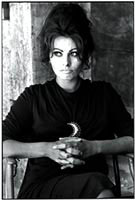Shooting star
Fashion photography changed radically in the 1960s, and Terence Donovan was at the forefront of the renaissance. A recent book of his work brings him right up to date.

There were three photographers who almost single-handedly defined the 1960s image of Swinging London. They were David Bailey, Brian Duffy and Terence Donovan.
The last-named, who died in 1996, is the subject of a sumptuous new coffee table retrospective designed by Pentagram partner David Hillman and edited by Hillman with Diana Donovan.
Donovan was, by all accounts, a mass of contradictions. Both gregarious and shy, confident and insecure, he had, according to Cecil Beaton, a driving ambition that did not allow him to rest.
Donovan, Bailey and Duffy all came from working class backgrounds and were all heterosexual, which marked them out from their predecessors. Emerging at a time of cultural upheaval and enlightenment, they set about challenging attitudes to photographing fashion.
Pre-1960s, men in fashion ads would invariably be posed perched on shooting sticks in Regent’s Park, looking manly, proud and upper-middle class. “So I thought, right, we’ll go to the gasworks,” Donovan told an interviewer at the time. He and the others shot their models on the streets, in the East End, and, later, against the grim realism of 1950s/ 1960s housing estates and tower blocks. The look they wanted was gritty, grainy and raw.
The images were just as staged and false as the old ones, of course, but they gave the illusion of cutting edge reality in keeping with the new British cinema of Room At The Top, and Saturday Night And Sunday Morning. Donovan found his natural home in the magazine Nova, which epitomised and encapsulated the 1960s for a generation. Nova’s quest for innovation enabled him to experiment with colour and processing as well as content.
Icons of the time – Celia Hammond, Jean Shrimpton, Grace Coddington, Mary Quant – feature prominently in the book, both in model shoots and in less formal guise. There are a couple of off-guard shots of Julie Christie, a great 1960s beauty, that suggest they were friends, if not lovers. It’s clear he adored women and, with one or two exceptions, his pictures are lusty celebrations of female sexuality (the exceptions teeter on the brink of porn).
When he died so dramatically and unexpectedly four years ago – he took his own life – Donovan had just completed a portfolio of Swinging London’s second coming for GQ magazine. The feature was called National Anthems and comprised rock heroes from Bryan Ferry to Jarvis Cocker. The issue hit the newstands only a week before his death. His last published photograph was a grainy portrait of the UK’s newest fashion star duo, Clements Ribeiro, for Vogue, reminiscent of a grainy portrait of Mary Quant he’d made 30 years ago.
A great bear of a man, Donovan was a judo black belt and a keen follower of Zen Buddhism. He believed in clearing his mind of whatever he felt he didn’t need to know. “The one thing I do know,” he told a friend, “is that I don’t know anything. It’s all out there to be discovered.”
Donovan’s appetite for new challenges took him into many areas other than photography. At various times he owned a chain of dress shops, a restaurant (with actor Terence Stamp) and a building contractor.
He also produced a number of films, commercials and pop videos, including the one for Robert Palmer’s 1986 hit Addicted to Love, now considered something of a classic for its simple, yet erotic stylishness.
Donovan’s suicide isn’t mentioned at all in the book, nor any problems, illness or depression that may have led to it. His friend, the film producer David Puttnam, says in a foreword that he “offered all of himself, all the time to whatever was at hand”.
With so much self-imposed pressure in his working life, it’s only surprising Donovan didn’t burn out sooner.
Terence Donovan is published by Little Brown on 4 October, priced at £50
-
Post a comment




